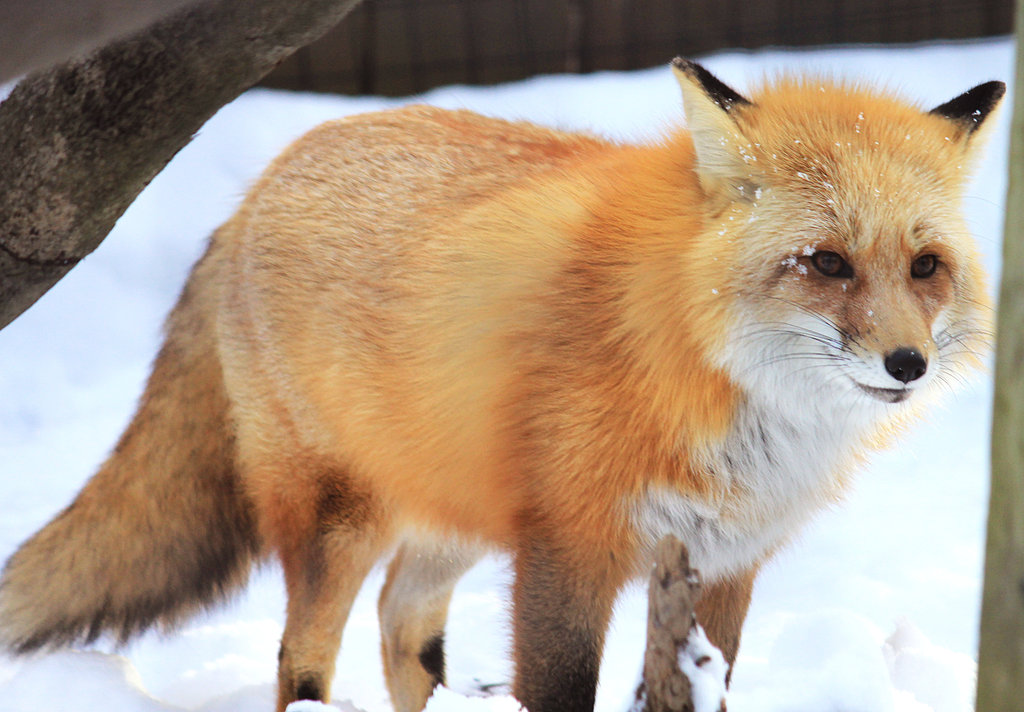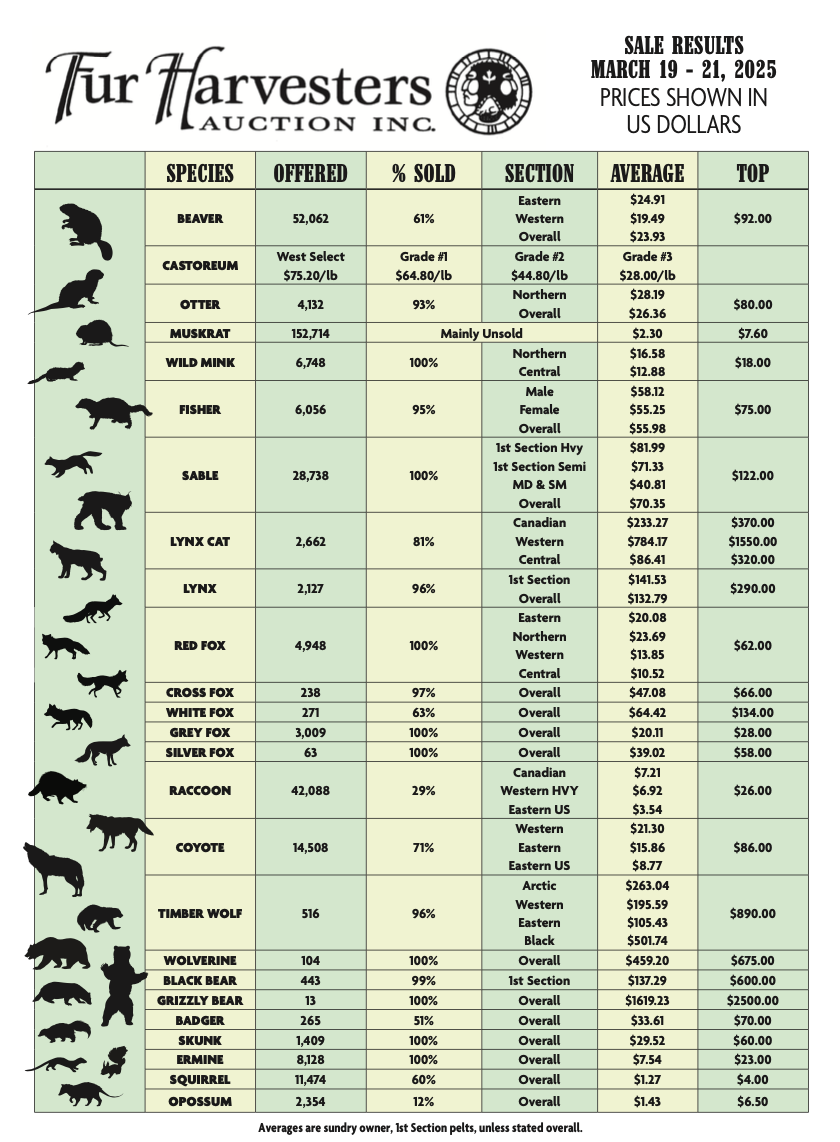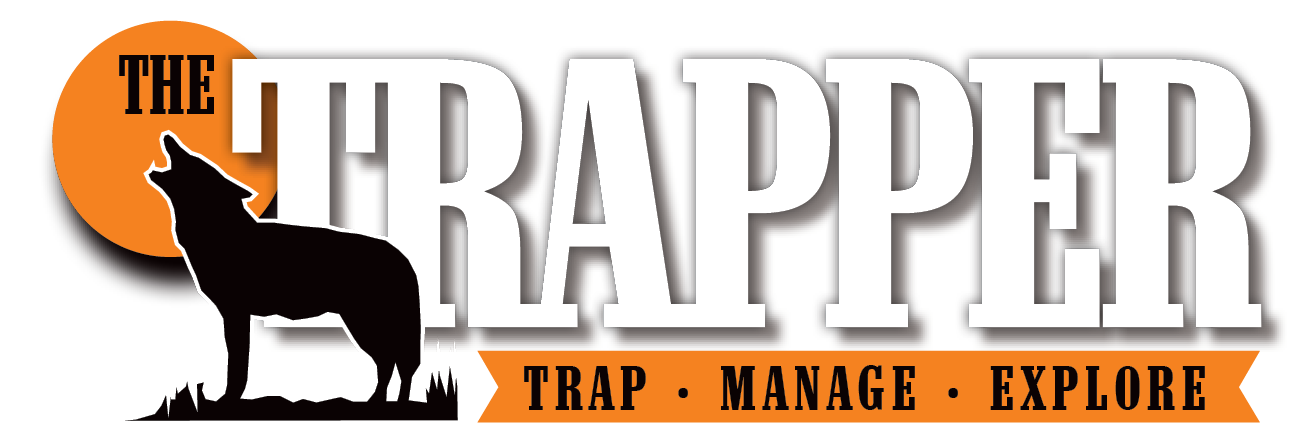The long anticipated sale at Fur Harvesters Auction in North Bay, Ontario, Canada, finally happened on March 19-21, 2025, and it may well be the very best sale we have seen in a long time! In the face of huge economic uncertainty, nonstop tariff discussions, war raging between Russia and Ukraine, buyers showed up in North Bay and the auction competition resulted in prices advances on many species. Finally! Okay, not all species are back to acceptable levels yet, but advances in prices must be celebrated, especially in recent years.
Marten, the staple of many northern traplines, was certainly one of the biggest winners in this sale. Best pelts, 1st section Heavy, meaning perfect fully prime pelts, average $81.99 and the overall average was $70.35 USD. This was a big step up from March 2024 when the same skins averaged $66.30 and $58.71, respectively. Marten trapping is easy if you have them, and access to good populations usually involves lots of travel by truck, snowmobile, foot or even plane if you live in Alaska! At $40 USD, trappers can expect to make expenses, so this March 2025 average is great news!
Staying with northern fur, Canada lynx also sold well at an overall average of $132.79 USD, a price structure greatly influenced by the recent surge in demand of the most expensive of all wild fur species, bobcat. Called Lynx cats in the fur trade, bobcats are always in great demand, especially the western skins and this year, western bobcats averaged $784.17 compared to $501.21 average in March 2024. Yes, you can read this again! One good bobcat pelt from the west with a white belly and beautiful black spots is worth almost $800 USD and the top price paid was $1550! Sure, not everyone has western cats on their trapline, But I would think that catching even just one a day would make for a fun and profitable trapping vacation! Eastern bobcats, with not so white bellies and less defined black spots, still averaged $233.27 at this March 2025 sale, which is enough to bring a smile to any eastern trappers’ face!

Staying with the northern trappers, all items that are wall-hangers or taxidermy goods did amazing – again. Wolves ($105-501), wolverines ($459.20 average), and black bears ($137.29 average) all sold well, as did the smaller but still somewhat exotic species such as badger ($33.61 average), weasels – called ermine in the trade ($7.54 average), and maybe most extraordinarily, skunks! There were 1409 skunk pelts offered at this March sale, and the overall average was $29.52 USD. Yes, you read that right, skunks averaged $30 dollars apiece! This skunk market is hot, and of course, the quantity is not that great. Skunk pelts usually make it to market as a bycatch of raccoon trappers, and with the terribly low prices on raccoons, fewer trappers harvest skunks incidentally. At this march sale, raccoons dropped even more, with the best Canadian and Western heavy pelts averaging $7.21 and $6.92, respectively. The eastern raccoon skins averaged a dismal $3.54 USD. No wonder we see more and more raccoons dead on the highways. Raccoon pelts typically end up in Russia, and that market is still impaired by the political and economic sanctions associated with the war between Russia and Ukraine. I say reverse your thinking. Trap skunks and catch raccoons incidentally. Currently, a good skunk is worthy 4 or 5 raccoon pelts!
Another group of trappers who catch skunks incidentally are fisher trappers, and that market is still good. At this past sale, male and female skins averaged $58.12 and $55.25, respectively, compared to $64.18 and $53.98 at the same time last year. Sure, there may be a small drop in price for males, but prices over $50 USD are more than acceptable.
Canine trappers all remember the good coyote years we had from 2013 to 2022, but this era is over. The coyote market is still weak from the post ‘parka trim’ era, and western skins averaged $21.30, whereas eastern coyote skins averaged $15.86. In the field, I tell all eastern coyote trappers to be selective in what they handle and skin – some coyotes are simply not worth skinning at current prices. In my neck of the woods, some trappers even charge farmers when asked to trap coyotes, or trade coyote trapping for deer or turkey hunting privileges. Coyote populations need management by trapping, but the current prices make it a labor of love more than one of money.
In contrast, the fox market seems to be rising. Red foxes, which have long been very low, are starting to climb up. Eastern red foxes averaged $20.08 and the best red fox from the north averaged $23.69. Last year, the same pelts averaged $16.64 and $17.19, respectively. I will agree that foxes below $30 USD depress me, but at least we are moving up. Foxes are light, easy to skin, fun to catch, and much easier to manage in large numbers than coyotes. Moreover, some foxes may be cross or silver, and these pelts do very well. At this past March sale, cross fox averaged $47.08 USD and silver fox $39.02 USD. Few trappers have these color phases in numbers, and usually, colored foxes occur either far north or on remote islands. If you have them, good for you, and take full advantage of this market. Plus, the red you catch still will bring you a $20 dollar bill!

Moving from land to water, things are less exciting. The beaver market, made fairly hot due to the hat market, has softened up and prices are dropping slowly. At this past sale, Eastern beaver pelts averaged $24.91, compared to $32.57 in March 2024, whereas western beaver pelts averaged $19.49, compared to $28.87 in March 2024. My advice on beaver remains the same, catch them when they are prime. There is no indication that the beaver market will move up for the coming year either, as the demand for the hatter market has been met and many pelts still wait to be transformed into hats.
River otter remained fairly stable at $26.36 USD average; a price still too low to justify excitement. Wild mink moved up with averages of $16.58 for northern skins. The low offering of ranch mink pelts probably plays a role in the current price of wild mink, but I am not sure this price will hold steady. Mink and muskrat trapping is fun, but there is absolutely no profit in it currently. Muskrats, what was once the core of many traplines, remain very tough to sell at averages dancing around the $2 mark.
In summary, prices moved up on northern terrestrial species, and this movement up is most welcome considering that the political and economic conditions worldwide are still unsettled. With the war continuing between Russia and Ukraine, discussions of tariffs and the uncertainty on prices for goods and commodities, we’ll take these prices with a smile and hope the trend continues in the next few months! The next international wild fur auction will be again in North Bay, Canada, June 17-19, 2025.

